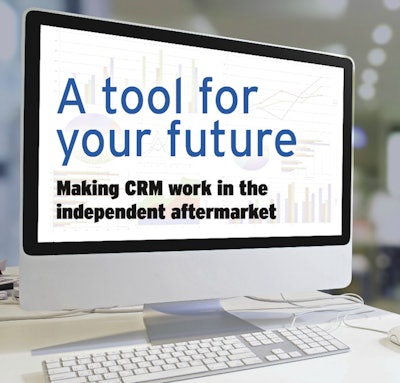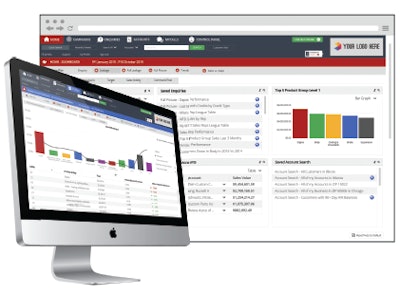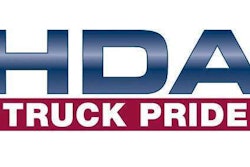The following comes from the October 2016 issue of Truck Parts & Service. To read a digital version of the magazine, please click the image below.

Business owners today have no shortage of options when looking for tools to help run their businesses.
One tool that’s starting to take off in the independent aftermarket is customer relationship management (CRM), which allows businesses to easily track, record and distribute customer interactions among a sales team. Available from a multitude of vendors, CRM is typically a customizable web-based tool that compiles the knowledge and notes of employees into a single, super database of customer information.
It’s a cheat sheet for a sales team. A personal sales notebook that everyone can read. And in some cases, it can be that and so much more.
For distributors looking for a leg up on the competition, or simply trying to sustain profit margins, CRM is a tool worth investigating.
The first step in making CRM work in your business is finding the right one.
There are scores of CRM systems now available in North America and each has distinct features and capabilities. And because CRM providers typically build their systems to work across multiple industries, each system’s adaptability to the independent aftermarket, and your business, is varied.
John Devany, sales manager at Betts Truck Parts & Service, says he first started investigating CRM tools for his business nearly three years ago. Devany says he wanted a tool that would allow his sales team to better log its call reports and share customer information across the company’s eight locations.
“We were still handwriting call reports and we had no ability to search through them,” he says. “It was difficult for our sales guys to go back and look at [past reports], and it was hard for us to track everything they were doing.
“We realized we needed something electronic, something with filters where we could easily search everything. We realized we needed to get into the future.”
Devany found several CRM systems capable of meeting his needs, but he also found some of those same programs featured additional technology and services that weren’t really necessary for what he was trying to do.
Bill Nolan had the same experience when he started looking for CRM systems to introduce at PBS Truck Parts. Nolan, the company’s president, wanted to provide his sales team a resource that would make it easier for them to complete call reports and improve daily productivity, but he also didn’t want to overwhelm them.
Adopting new technology can be a struggle for any business, and with an older sales team that was used to doing things the “old fashioned way,” Nolan says he didn’t want to invest in a tool his team would resist or be unable to understand.
“We didn’t want something that would be superfluous in its detail or complexity,” he says.
He and Devany eventually found the tool for them when they were introduced to Sales-i.
Founded in the United Kingdom in 2008, Sales-i is a CRM provider that caters specifically to “any company involved in the supply chain,” says Co- Founder Kevin McGirl.
The company began doing business in North America in 2011 and within two years the business was garnering interest from automotive and heavy-duty aftermarket operations.
Thanks to a simple user interface designed with veteran sales people in mind, McGirl says Sales-i is able to provide aftermarket distributors the CRM functionality they require without the unnecessary bells and whistles found in other common systems.
The latter is an another important aspect in selecting a CRM. Simplicity — or the appearance of simplicity, distributors say — is valuable. Visually cumbersome systems can create confusion and user angst, and ultimately have a negative impact on a business.
“Make sure the CRM tool you select matches your business activities rather than having your business have to match the CRM,” says Robyn Spitzke, president at Fort Garry Industries and another Sales-i user.
At Fleet Brake, President John Bzeta says he’s kept that in mind as he’s expanded the capabilities of his CRM, Insightly.
Bzeta says when Fleet Brake first began using Insightly five years ago it was almost exclusively for call reporting. In the years since he’s added features to enhance the tool but has always strived to keep the dashboard and user experience stable, ensuring his team remains comfortable.
“You want everyone to be able to use it effectively,” he says.
And usage matters. It’s only once sales people buy-in that purchasing a CRM becomes worthwhile.

Sales people need to see how a CRM will make their job easier, they need to see what it will do for them, and then they need guidance to understand how to make it do exactly that, says Greg Rawleigh, general manager at DeCarolis Heavy Duty Parts.
“It’s hard to tell your [people] they’re going to be expected to use something if they don’t see its value,” says Rawleigh, who also is using Sales-i. “You have to show them.”
Sales-i does that not only with its user-friendly interface but also with a comprehensive sales data analytics package, which, like the CRM itself, was designed with the outside sales person in mind.
“We realized in the supply chain you have a whole bunch of sales people who were out there in the field and were finding traditional CRMs to be very difficult to use,” says McGirl. “Most CRMs are service or process focused, and they weren’t providing the salespeople what they needed.”
He adds, “They wanted transactional data.”
Sales-i’s system allows distributors to transfer all of their transactional sales data from their business systems into the CRM, which then easily translates and aggregates the information into a simple, searchable database that sales people can use to better understand the buying habits and changes of their customers. And because the entire system is customizable, McGirl says distributors can easily manage the amount of data they choose to present to their sales team as needed.
Education on the system itself matters, too.
Sales people can perceive a CRM as a watchdog, a tool designed to monitor their every move and customer interaction. Distributors using CRM say it’s not that at all, but until sales people know that, they can be resistant.
“We definitely had some resistors at first,” says Nolan. “They didn’t see why they needed to do things differently and didn’t want to change.”
Nolan says a brief tutorial showing his team how they could now log call reports in minutes using voice-to-text phone software, and another lesson on how to produce customer purchasing snapshots quickly turned heads.
“We knew when we turned one of our toughest [resistors] that everyone was coming around.”
“You definitely see some people have that lightbulb moment,” says Doug Gaddis, vice president at another Sales-i user, Ogburn’s Truck Parts.
It’s at this point that training becomes invaluable.
Most CRM providers include introductory training for sales people of new customers who purchase rights to a system. It’s in this period that distributors can take their employees from intrigued to committed, and that’s when a CRM really begins to work.
But Gaddis warns that total adoption isn’t immediate, even post-training.
“I remember we had some people who understood it immediately but not everyone,” he says. “It definitely takes coaching for people who are not used to looking at data or using software. There’s a learning curve, and it takes a while to get everyone on the same page.”
“Adoption is a slow process,” adds Spitzke. “You are changing how people do their jobs and there will always be some hesitation to share their relationship, or perhaps their lack of relationship, with their customer.”
Devany says he’s combated this concern at Betts Truck Parts by stressing how CRM can improve the quality of each customer touch. CRM creates transparency throughout a sales force that allows associates to be better informed during every customer interaction.
“We want the quality of our touches [to be] at the highest level possible,” he says.
Bzeta agrees, and says he’s witnessed CRM do that for Fleet Brake. He even has examples, citing a recent case where the sales of a product line by a sales person in one area triggered a sales person two time zones away to propose, and then close, a similar sale.
“The other sales person saw [what the first had done] and made a similar proposal to a similar customer and we received some new business,” he says.
“You don’t all have to be in the same room to understand the same information about your customer base. You don’t have to be in the same room with the sales guy or the counter guy,” says HDA Truck Pride Director of Marketing Kristen Phipps. “Everything is there for everyone.”
CRM is a pretty handy time-saver, too.
“On the conservative side I would think it frees up nearly an hour per day in paperwork for a sales rep,” says Rawleigh.

All of these features make CRM a worthwhile endeavor.
“I don’t think most companies have [customer] database programs to retrieve and capture customer information in the manner that CRM programs have today,” says Gaddis. “It helps your sales people become better at what they do.”
Devany agrees, adding that CRM helps the independent aftermarket keep pace with tech-savvy and well-funded competitors.
“I think with where technology is going if people don’t start embracing this they’ll be passed by. [Competitors] are becoming more and more advanced. It’s going to be difficult for aftermarket businesses to stay in stride with them without these tools,” he says.
Yet it’s also important to recognize a CRM isn’t a miracle cure.
“It’s one of those things where you get out of it what you put into it,” says Phipps. “If you don’t put the information in correctly or don’t train your people on how to benefit from it they aren’t going to.”
“A CRM cannot improve your business. What it does is give you visibility into issues,” adds Spitzke. “It provides you with the information so you can react accordingly. It provides management with more information on what is happening at a ground level and provides sales with a more professional set of tools to stay on top of issues and opportunities.”










